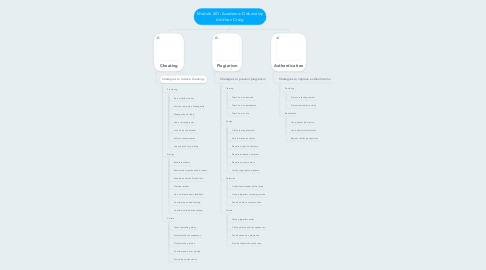
1. Authentication
1.1. Strategies to improve authentication
1.1.1. Proctoring
1.1.1.1. Proctor in testing centers
1.1.1.2. Proctor remotely via video
1.1.2. Identificaton
1.1.2.1. Use physical biometrics
1.1.2.2. Use behavioral biometrics
1.1.2.3. Require challenge questions
2. Cheating
2.1. Strategies to reduce cheating:
2.1.1. Proctoring
2.1.1.1. Be a mobile monitor
2.1.1.2. Position computers Strategically
2.1.1.3. Manage the desktop
2.1.1.4. Use a remote proctor
2.1.1.5. Lock down the browser
2.1.1.6. Enforce consequences
2.1.1.7. Use analytics for profiling
2.1.2. Design
2.1.2.1. Rotate test items
2.1.2.2. Randomize questions and answers
2.1.2.3. Shedule once with limited time
2.1.2.4. Disallow retakes
2.1.2.5. Do not release items feedback
2.1.2.6. Consider open book testing
2.1.2.7. Consider collaborative testing
2.1.3. Culture
2.1.3.1. Teach test-taking ethics
2.1.3.2. Articulate the consequences
2.1.3.3. Clarify device policies
2.1.3.4. Consider and honor pledge
2.1.3.5. Punish those who cheat
3. Plagiarism
3.1. Strategies to prevent plagiarism
3.1.1. Training
3.1.1.1. Teach how to research
3.1.1.2. Teach how to paraphrase
3.1.1.3. Teach how to cite
3.1.2. Design
3.1.2.1. Clarify the requirements
3.1.2.2. Vary the research topics
3.1.2.3. Require a specific structure
3.1.2.4. Require evidence of process
3.1.2.5. Require current content
3.1.2.6. Justify copyright compliance
3.1.3. Detection
3.1.3.1. Understand student ability levels
3.1.3.2. Use a plagiarism screening service
3.1.3.3. Search dubious content online
3.1.4. Culture
3.1.4.1. Teach plagiarism ethics
3.1.4.2. Clarify policies and consequences
3.1.4.3. Punish those who plagiarize
3.1.4.4. Provide feedback at each step
